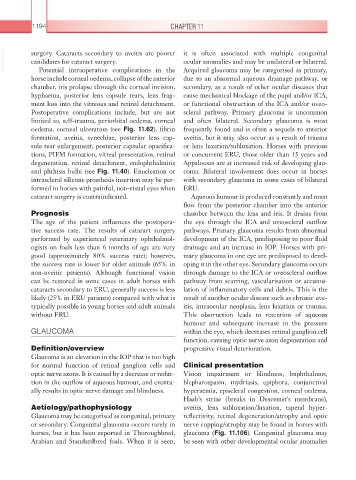Page 1219 - Equine Clinical Medicine, Surgery and Reproduction, 2nd Edition
P. 1219
1194 CHAPTER 11
VetBooks.ir surgery. Cataracts secondary to uveitis are poorer it is often associated with multiple congenital
ocular anomalies and may be unilateral or bilateral.
candidates for cataract surgery.
Potential intraoperative complications in the
horse include corneal oedema, collapse of the anterior Acquired glaucoma may be categorised as primary,
due to an abnormal aqueous drainage pathway, or
chamber, iris prolapse through the corneal incision, secondary, as a result of other ocular diseases that
hyphaema, posterior lens capsule tears, lens frag- cause mechanical blockage of the pupil and/or ICA,
ment loss into the vitreous and retinal detachment. or functional obstruction of the ICA and/or uveo-
Postoperative complications include, but are not scleral pathway. Primary glaucoma is uncommon
limited to, self-trauma, periorbital oedema, corneal and often bilateral. Secondary glaucoma is most
oedema, corneal ulceration (see Fig. 11.62), fibrin frequently found and is often a sequela to anterior
formation, uveitis, synechiae, posterior lens cap- uveitis, but it may also occur as a result of trauma
sule tear enlargement, posterior capsular opacifica- or lens luxation/subluxation. Horses with previous
tions, PIFM formation, vitreal presentation, retinal or concurrent ERU, those older than 15 years and
degeneration, retinal detachment, endophthalmitis Appaloosas are at increased risk of developing glau-
and phthisis bulbi (see Fig. 11.40). Enucleation or coma. Bilateral involvement does occur in horses
intrascleral silicone prosthesis insertion may be per- with secondary glaucoma in some cases of bilateral
formed in horses with painful, non-visual eyes when ERU.
cataract surgery is contraindicated. Aqueous humour is produced constantly and must
flow from the posterior chamber into the anterior
Prognosis chamber between the lens and iris. It drains from
The age of the patient influences the postopera- the eye through the ICA and uveoscleral outflow
tive success rate. The results of cataract surgery pathways. Primary glaucoma results from abnormal
performed by experienced veterinary ophthalmol- development of the ICA, predisposing to poor fluid
ogists on foals less than 6 months of age are very drainage and an increase in IOP. Horses with pri-
good (approximately 80% success rate); however, mary glaucoma in one eye are predisposed to devel-
the success rate is lower for older animals (65% in oping it in the other eye. Secondary glaucoma occurs
non-uveitic patients). Although functional vision through damage to the ICA or uveoscleral outflow
can be restored in some cases in adult horses with pathway from scarring, vascularisation or accumu-
cataracts secondary to ERU, generally success is less lation of inflammatory cells and debris. This is the
likely (25% in ERU patients) compared with what is result of another ocular disease such as chronic uve-
typically possible in young horses and adult animals itis, intraocular neoplasia, lens luxation or trauma.
without ERU. This obstruction leads to retention of aqueous
humour and subsequent increase in the pressure
GLAUCOMA within the eye, which decreases retinal ganglion cell
function, causing optic nerve axon degeneration and
Definition/overview progressive visual deterioration.
Glaucoma is an elevation in the IOP that is too high
for normal function of retinal ganglion cells and Clinical presentation
optic nerve axons. It is caused by a decrease or reduc- Vision impairment or blindness, buphthalmos,
tion in the outflow of aqueous humour, and eventu- blepharospasm, mydriasis, epiphora, conjunctival
ally results in optic nerve damage and blindness. hyperaemia, episcleral congestion, corneal oedema,
Haab’s striae (breaks in Descemet’s membrane),
Aetiology/pathophysiology uveitis, lens subluxation/luxation, tapetal hyper-
Glaucoma may be categorised as congenital, primary reflectivity, retinal degeneration/atrophy and optic
or secondary. Congenital glaucoma occurs rarely in nerve cupping/atrophy may be found in horses with
horses, but it has been reported in Thoroughbred, glaucoma (Fig. 11.106). Congenital glaucoma may
Arabian and Standardbred foals. When it is seen, be seen with other developmental ocular anomalies

